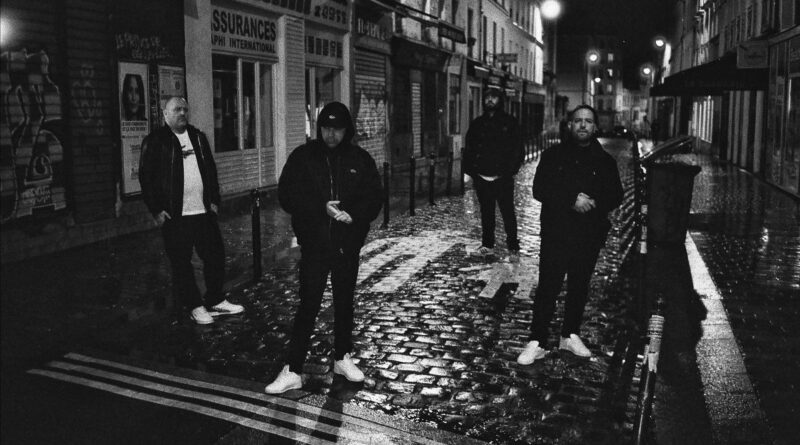Hangman’s Chair: Down And Out In Paris
Heavy metal is made by outsiders, for outsiders, and about outsiders. As far back as BLACK SABBATH’s debut Lucifer features in heavy metal as the quintessential outsider, but you don’t have to be beelzebub to be an outsider. HANGMAN’S CHAIR have explored the figure of the outsider from the beginning, with songs and imagery that cast a light on society’s maligned individuals. “Since the first album, our main topics included suicidal thoughts, alcohol abuse, and drug use,” explains guitarist Julien Rour Chanut, “and that’s simply because we were living that life. We’ve been through it, and we liked to talk about it in a nihilistic and cynical way.”
“I’m also a big fan of documentaries, such as Cut Up Kids, Streetwise, Dope Sick Love, Black Tar Heroin, Whores Glory,” he continues. “Those have all been huge influences on the band. Those harsh reality documentaries really fascinate me,” he muses, “just take a look at some of the samples we used in the past, like Acephale, Rest in Pieces: A Portrait of Joe Coleman, Paris Interdit, Story Of A Junkie. It’s all in the same vein.”
“All these topics have played a role in our music at some point,” he explains. “When Cédric [Toufouti] joined the band, he added a more metaphorical way to express these feelings. At the time of Banlieue Triste, one member of the band survived an overdose, and that’s when we started to get more introspective and to use those personal issues as our main themes.”
HANGMAN’S CHAIR transforms this gritty, homespun negativity into something beguiling and beautiful, with their signature gothic doom sound. “We surely want to put a certain aesthetic to this negativity, and the issues we are confronted with. HANGMAN’S CHAIR is the way we found to express ourselves,” he adds, “instead of talking to someone else or even going to a shrink. For my part I’m not a big talker and writing riffs and lyrics is a kind of escape,” he confesses, “but only when I have recovered enough so that my head is clear.”
Their new album A Loner renders it’s theme with a new and bold artistic style for the band. “The character on the album cover is a random person in the street,” Julien explains. “We asked the photographer Christopher De Bethune to give us his vision of loneliness, and his style is to shoot a stolen moment in the street, so he came up with this picture: a random solitary guy waiting for nothing on a bench.”
The album’s singles also expand on and explore the portrait theme. “The artwork on the Loner single is a screenshot of the Loner video, which was directed by Kendy Ty. It features my friend Michel, showing his prison tattoo. Once again, a real life person,” he observes. “For the Cold & Distant single Dehn Sora, who was in charge of the artwork concept of the album, made this artwork. I believe it’s a drawing,” he adds. “It’s only since Banlieue Triste that we began to use photographs to illustrate our albums,” he recalls, “before that, we were more into drawings. There is no particular reason for choosing to go with a photographic style, we just give free rein to each artwork designer we work with.”
Like all artists, HANGMAN’S CHAIR are the product of both their surroundings and their circumstances. Operating from the Parisian suburbs, they shine a light on the reality which they live in. “From the beginning we tried to be different and not use the clichés of our genre,” explains Julien, “whether that’s from the hardcore scene or the doom/sludge scene. We cannot deny those influences but we had to incorporate our own identity which, in this case, is the fact that we come from Paris. It was really important for us to distinguish ourselves,” he adds. “That’s why our artwork has also featured Apaches (Parisian thugs from the twentieth century) and other typical French references. For the music itself, I don’t think you will hear anything in it that will remind you of Paris,” he reflects, “but perhaps just the fact that we come from a big city. Maybe you can feel the coldness, the grey concrete mixed with artificial neon lights? That’s what you can hear in A Loner.”
The band has existed since 2005, with members coming and going along the way, but they have come a long way from the hardcore, DIY style of their first album. “I don’t feel like our motivations have changed: creating something which comes from our own experiences, trying to be proud of it and playing it to others,” muses Julien. “We’ve been playing in the same circles on and on for so long!” We ask what has changed for HANGMAN’S CHAIR in their seventeen years as a band. “To this day, it’s still the same. Our main goal is to keep playing with total freedom; with no restrictions.”
“The only thing that has changed is our relationships,” he explains. “We’re in our forties now, and all relationships have to evolve if they’re going to work. That’s particularly relevant for me and Mehdi [Birouk Thépegnier] who are the two remaining original members and founders of HANGMAN’S CHAIR. We have been friends for about 30 years,” he tells us proudly. “We met at school at the age of twelve and we are still friends to this day, even though we are completely different. That’s what makes us complementary, and music is what makes us stay together at the end of the day. I have learned that if you keep doing what you do with integrity, then you will last longer,” he concludes. “Perseverance is everything, and even if we were not the most talented, we were definitely the most passionate.”
A Loner is out now via Nuclear Blast Records.
Like HANGMAN’S CHAIR on Facebook.

